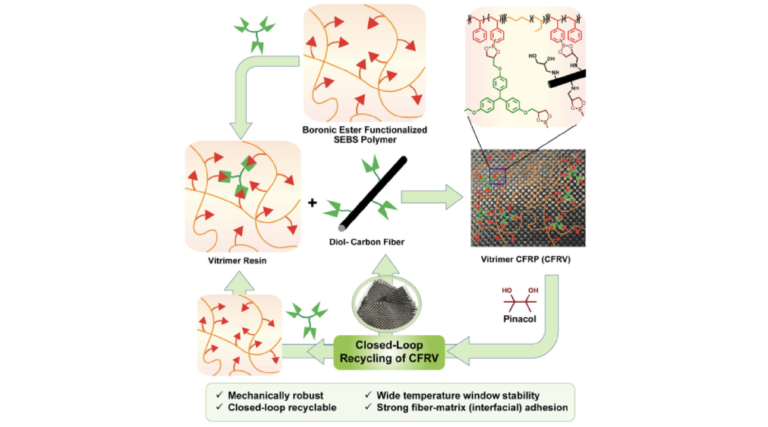Funded by the Vehicle Technologies Office in the Department of Energy’s (DoE) Office of Energy Efficiency and Renewable Energy, researchers at DoE’s Oak Ridge National Laboratory (ORNL) in Tennessee, have developed a closed-loop process for creating a highly durable carbon-fiber-reinforced polymer (CFRP) and reclaiming all its raw materials afterward.
CFRP is a valuable material for industries seeking lightweight, strong and tough composites to enhance fuel efficiency and performance in automobiles, aircraft and spacecraft. However, traditional CFRPs are challenging to recycle, resulting in significant environmental impact due to their single-use nature. The ORNL innovation addresses this challenge by introducing a closed-loop technology, detailed in an open-access paper published in Cell Reports Physical Science.
Once formed, conventional thermoset materials are permanently cross-linked and cannot be reprocessed. In contrast, ORNL’s system incorporates dynamic chemical groups into the polymer matrix and its embedded carbon fibers, allowing for multiple reprocessing cycles without compromising mechanical properties such as strength and toughness.
Led by ORNL chemist Tomonori Saito and researcher Anisur Rahman, the team has applied for a patent for the process. They say that by incorporating dynamic covalent bonds, the interface securely locks materials together and can be selectively unlocked using heat or chemistry, enabling efficient recycling without loss of starting materials.
According to the researchers, the technology enables closed-loop recycling at the laboratory scale and offers other features such as quick thermosetting, self-adhesive properties and the ability to repair microcracks within the composite matrix.
The team undertook a detailed characterization of the material, including tensile properties, chemical mapping, rheological analysis and microscopy.
Inspired by nature’s dynamic interfaces, such as those found in nacre, the researchers aimed to optimize interfacial chemistry between carbon fibers and the polymer matrix to enhance interfacial adhesion and CFRP toughness. The resulting material exhibited tensile strength, which the team claim surpassed that of stainless steel and conventional epoxy-based CFRP composites used in automobiles.
“The fiber and the polymer have a very strong interfacial adhesion due to the presence of dynamic bonds. The functionalized fiber has dynamic exchangeable cross-linking with this polymer. The composite structure is really tough because of the interface characteristics. That makes a very, very strong material,” said Saito.
Rahman added, “We found 5% cross-linking works better than 50%. If we increase the cross-linker amount, it starts making the polymer brittle. That’s because our cross-linker has three hand-like bulky structures, able to make more connections and decrease the polymer’s flexibility.”
Looking ahead, the researchers aim to extend their studies to glass-fiber composites to further reduce costs across industries, including aerospace, automotive, marine and construction.
For more sustainability news, please click here.



